
ONE THING NEEDFUL
SPRING 2014
If ye abide in me, and my words abide in you, ye shall ask what ye will and it shall be done unto you. Herein is my Father glorified, that ye bear much fruit; so shall ye be my disciples. — John 15:7-8
Christ asks each of us to stand fast in His words which, through the help of the Holy Spirit, command us to love God and humankind, to learn to turn ourselves toward Him in constant prayer, to remember that He is always with us whether we feel His presence or not, to work at cleansing our hearts through fasting from the passions, to replace passions with good works, and to ask for discernment to know His voice and to be obedient to Him. Thus, as the Holy Spirit directs us, and we struggle, we grow in unity with the Triune God. We no longer seek that which is self-satisfying, but rather God glorifying. We ask for those things which direct our souls and the souls of others towards God. These things God gives us, because we ask for that which leads to life eternal. Therefore, by striving to become one with Christ and by asking for good things, we are able to bear fruit in Christ whose words are alive in us. By Christ’s words being written on our hearts, and thus, abiding in us, we find that we have become His disciples who willingly, joyfully, and lovingly follow Him, and Him alone.

MONASTERY NEWS
Retraction: In the last issue of our newsletter, we blamed a hawk for taking one of our ducks. The day that the Winter newsletter went to press, Mother Helena heard her quack and found her trapped between a bale of hay and the wall of the duck shed. She recovered, thanks be to God.
The forest green metal roof has been installed over the main section of the building and the outside stairwell. The base of the cupola is now covered with red blend brick veneer. All of the windows and the two, double French doors are now in place in the sun room. Below on the left is a picture of the south side and on the right a picture of the northeast side.
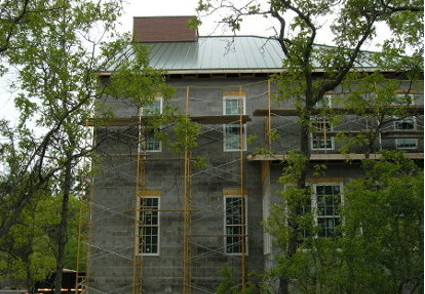
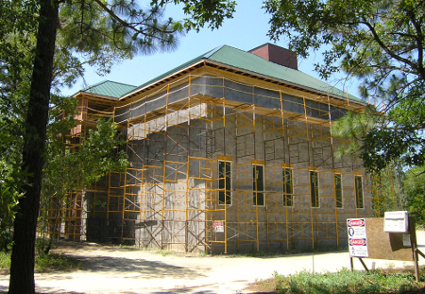
With the coordination and help of friends in Pennsylvania and South Carolina, the altar that had been at Saint Mary Russian Orthodox Church in Williamsburg, Pennsylvania, was freighted up by Ron Skvir and a friend, shipped via ABF Freight to Columbia, South Carolina, picked up and brought here by Fulmer Monument Company, and offloaded by a number of workers that were scheduled to be here on April 14th.
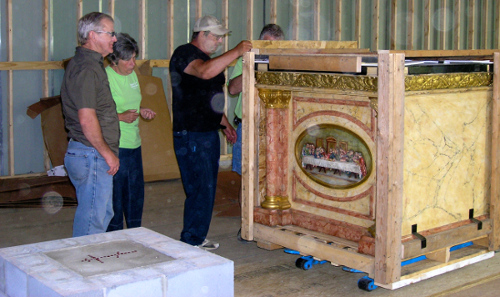
Not knowing when or if the raised altar platform would be build before May 3rd, the day of our annual pilgrimage, we made several contingency plans. With the altar set in place, the six framers arrived early on Friday, May 2nd, completed the job, and cleaned up the area shortly after 5pm. The three of us, armed with shop vacuum, extra cleaning paraphernalia, and all the items needed for Liturgy and the other services of Pilgrimage, plunged ourselves into the task and had everything ready before dark. (There is no lighting in the building yet, just an outside electrical pole.)
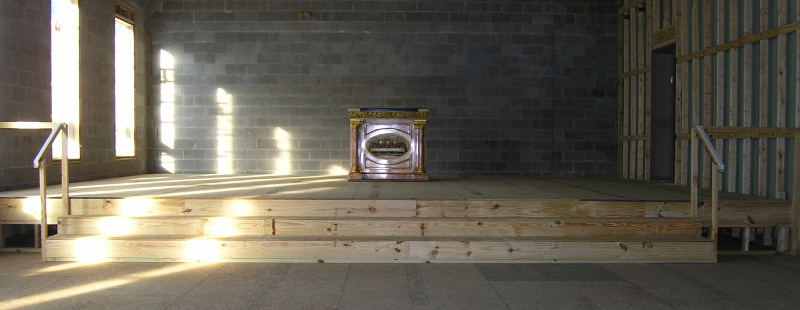
With perfect weather, the monastery’s Fifteenth Annual Pilgrimage was truly a Spirit-filled day. Many who were present spoke of the way the place permeated with the Holy Spirit and were enriched by simply being there. Although the building is a long way from finished, there was an incredible joy and beauty to all the services, especially since this was the first Liturgy served in the new chapel. The acoustics were marvelous, and all of us hope they will stay this way after the inside is finished. Below is a picture taken just after Liturgy of those who attended.

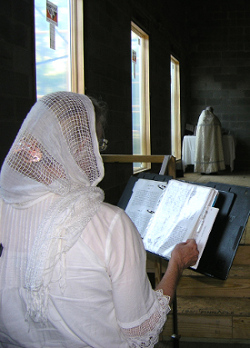
In the picture to the left, the beginning of Matins is prayed while Fr. Thomas Moore prepares the bread and wine to be consecrated during Divine Liturgy (Proskomedia). Below, Fr. Thomas is on the left finishing Proskomedia while Fr. John Parker is on the right. These pictures provide you with an idea of the size of this chapel (29’ wide, 50’ long, and 28’ tall).
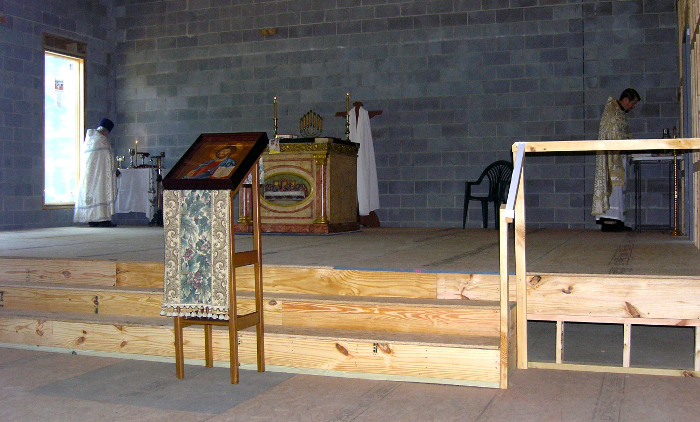
With natural lighting, the choir situated their music stands in front of one of the large windows. Although small in number, the acoustics in the chapel magnified our voices beautifully.
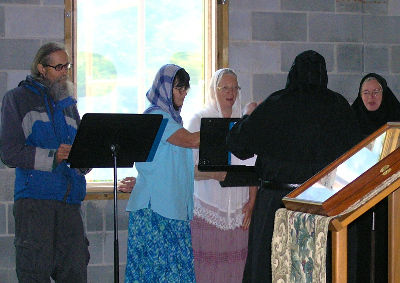
After a wonderful repast and fellowship in the double wide, we walked back to the chapel and prayed an Akathist to Saints Mary and Martha of Bethany and a Panahkida for the departed. Then everyone walked around the cemetery while Fr. Thomas blessed each grave and the choir sang the Matins’ Canon of Pascha.
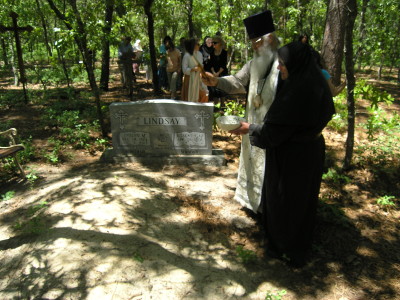
Afterwards, the children had a great time playing in the sand building tunnels. It was a joy to see them using their imagination and playing well with each other.
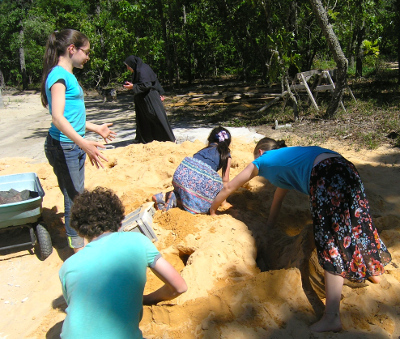
With all the comings and the goings of the day, a few hardy souls stayed for Vespers (pictured below). All in all we had a total of 71 people join us for our Fifteenth Annual Pilgrimage.


Digressing to mid-March, we were presented with the need of a recent widow to find a home for her late husband’s dog. While Laufey had died in mid-February, we were not sure that we should get a second dog this soon; however, after some discussion, we felt we could adopt Lady, an eight-year-old Australian Shepherd with blue eyes. Corelli, who is eleven, and Lady are slowly working things out between them.
Sunday, March 30th was a long day in which Lady had to travel with us. We attended Liturgy at Holy Apostles in the morning, drove to Saint John of the Ladder Orthodox Church in Greenville, South Carolina, for their ground breaking at the site for their new church, and then return to the monastery. While we waited at the site, we had a lovely time meeting new people and visiting with old friends. Dog lovers wanted to meet the “Aussie”. They have a beautiful plan for their new church. May God build the house.
We were busy throughout the season of Lent and Holy Week as usual. Celebrating the Resurrection, The Feast of Feasts, uplifts our souls and reminds us why we follow Christ. By the time we arrived at Bright Week, the week after Pascha (Easter) in which we celebrate the Pascal Service again each day, we were hard-pressed to summon the strength to extol His praises for His gift of salvation.
On Thursday of Bright Week, Don (Dusan) Pecic was buried here. Also, we have had two additional burials here — Vladimir Korchak on June 2nd, and Vladimir Vasil’yevich Agafonova on June 13th. May their memory be eternal!
Often, those who have loved ones buried here, come to check on their graves and leave plants and other items. Several grave stones have been added this last quarter.
With the ice storm having brutally broken off large tree branches and felled many trees, our forest floor was covered with the debris. At different times,several individuals and groups of volunteers helped to clear the fallen trees and branches from the sides of our drives, along Spinner Lane, and in the cemetery and haul them to burn piles on Candle Shop Lane (our drive leading to the candle shop). We would burn these piles as weather and lack of wind and time permitted.
Well-built, new doors were installed on the red shed. The old ones were more than eighteen years old and dilapidated. Insulation was added in the wall between the first two bedrooms. A small herb garden was planted behind the Barne Shoppes. The asparagus section was partially revived with the addition of fifty crowns. The floor of the Saint Joseph’s Candle Shop has been cleaned up and is now less of a tripping hazard. A made to fit arching trellis was set in placed over the doorway to the candle shop so the confederate jasmine can grow over it and onto the trellis on the right side of the door. This and much more has been accomplished this Spring. We always have a “To Do” list.
On May 17th, Mother Thecla led a retreat at Saint Mary Magdalene Orthodox Church in Rincon, Georgia. Over the years, we have come to know and love many of the parishioners there.
Having lost two ducks to a predator, we now have 11 ducks and 18 ducklings.

HIEROMARTYR CORNELIUS &
MONK MARTYR BASSIAN
(February 20th)
The Pskov Caves Monastery (Pskov-Perchersky Monastery) has an uninterrupted history that begins prior to its official founding in 1472 when the first Cave Church of the Dormition of the Theotokos was built. Some years before, a few hermit monks were looking for a place to practice their form of eremitic monasticism and happened upon one of the Pskov caves that had an inscription left by a previous hermit which read “cave given by God”. It was in these caves, located on the steep banks of the River Kamenets in western Russia near Estonia and Latvia, that the Pskov Caves Monastery was established.
Hieromonk Ivan (Shestnik) who was fleeing persecution from the Roman Catholics in Estonia is recorded as the first abbot of this monastery. His successor, Hieromonk Misael, guided the monks from eremitic to cenobitic monasticism. In 1510 the Knights of the Livonian Order, an autonomous branch of the Teutonic Order and part of the Livonian Confederation, laid waste to the monastery. This disaster combined with Pskov being annexed by the Grand Duchy of Moscow precipitated a decline in the monastery.
Cornelius (Kornily) was born in Pskov to Boyar parents, Stephen and Maria, in 1501. Wanting to provide their son with a good education, they sent him to the Mirozhsky Monastery in Pskov to study under the guidance of one of the Elders. There Cornelius learned letters and general math and history, as well as how to transcribe and adorn books, to paint icons, to make candles, to chop wood, and other necessary skills to live in a northern climate. During this time, Cornelius accompanied a government clerk to the Pskov Caves Monastery. Even though the monastery buildings were in abysmal conditions and the monks very poor, the Holy Spirit used the incredible natural beauty of the monastery’s setting and the heart-felt, inspiring prayer services of the monks to beckon Cornelius to fulfill his monastic calling there. Having finished his studies and returned home, he unhesitatingly knew that he would become a monk.
The year before Cornelius embarked on his monastic life, Deacon Misyur (Michael Grigorievich Munekhin), an official representative of the Grand Duchy of Moscow in Pskov, became a patron of the Pskov Caves Monastery, began helping to rebuild it, and started a settlement near the monastery. The caves were being enlarged when the nineteen-year-old Cornelius entered in 1520.
Being totally dedicated to God, well educated, disciplined in prayer and fasting, blessed with a vision of what the monastery could be, and graced with health and strength, Cornelius became the abbot and spiritual leader of the Pskov Caves Monastery at twenty-eight years of age (1529).
Under his spiritual leadership, the number of monks increased to two hundred. A number which has not been surpassed since. Abbot Cornelius sent many of these monks to a nearby monastery to be trained as iconographers. A library was established and be-came renowned for its impressive collection of manuscripts. Others were sent out as missionaries to the Aesti and Sitones peoples living near the monastery. Churches, hospices, and orphanages were built.
Following the tradition of his day, Saint Cornelius contributed to the Pskov Chronicles in 1547 and 1567, initiated the monastery’s Synodikon (a list of the departed), and wrote “An Account of the Origins of the Pechersk Monastery”, a “Description of the Monastery”, and a “Description of the Miracles of the Pechersk Icon of the Theotokos” (also known as Umilenie-Tenderness and Pskovo-Pechersk Icon of the Theotokos). It is important to note that this icon was brought to the monastery in 1521 by two Pskov merchants, Vasilii and Feodor, and is a miracle working icon which is most noted for protecting Pskov and the monastery from the invading Polish army of King Stefan Bathory on May 21, 1581, and from Napoleon’s army on October 7, 1812.
Numerous improvements were made to the Pskov Caves Monastery during Cornelius’ forty-one years as abbot. The caves continued to be enlarged; however, other accommodations were built as a residence for the monks. Since then the caves have been used as a cemetery for monks and laymen. It is estimated that some 14,000 have been buried there to date. A belfry was built which was comprised of original bells from 1540 and 1544; larger bells were presented to the monastery by Ivan the Terrible in 1561 and 1562; and, a large bell was bestowed upon the monastery by Peter the Great in 1690. The year of 1541 witnessed the relocation of the old wooden Church of the Forty Martyrs of Sebaste and the construction of the Church of the Annunciation there upon. Then less than two decades later the Church of the Protection of the most Holy Theotokos was built.
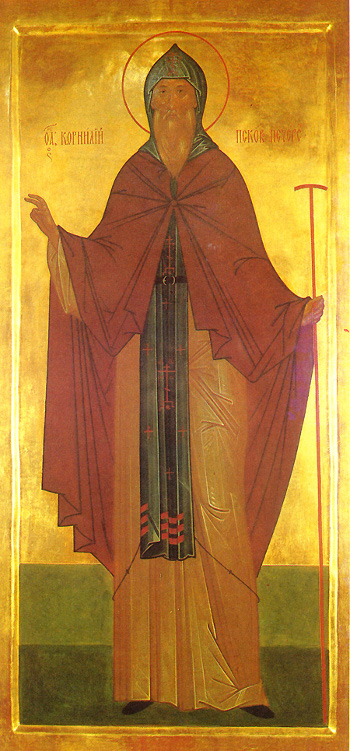
During the Livonian War (a war for control of the Baltic between Russia and the German states of Livonia [present day Estonia and Latvia] and the Polish Lithuanian Union from 1558-1583), the monastery became a refuge for many of its victims and, when needed, was temporarily converted into a hospital. Knowing that the earthen and wooden wall around the monastery’s perimeter was inadequate, Abbot Cornelius had the old walls torn down and replaced with massive stone walls and towers which included the settlement as well as the monastery. This enormous undertaking took ten years (1558-1567). Over the gate was built a church dedicated to Saint Nicholas the Wonderworker of Myra and Lycia to whom the protection of the monastery and settlement was entrusted (1564).
Since there was no separation of church and state and the Pskov Caves Monastery was part of the Grand Duchy of Moscow, the Abbot naturally aligned himself with Tsar Ivan IV (the Terrible) and supported the Russian troops. Prince Andrey Mikhailovich Kurbsky of the Grand Duchy of Lithuania was a long-time friend of and adviser to Tsar Ivan IV and led the Russian troops, often in victory, until the Tsar failed to renew his commission. So on April 30, 1564, Prince Kurbsky defected to Sigismund II Augustus, King of Poland and Grand Duke of Lithuania, and led the Polish-Lithuanian army in a great victory against Russia.
One of the Pskov monks, Bassian (Muromtzeff), was a friend of Prince Andrey. Upon hearing that Kurbsky had committed treason, Cornelius and Bassian severed all ties with him. But irreversible damage had already been spoken by those nearest the Tsar against the Abbot Cornelius and his monastery. Insinuations were made that Cornelius had built the massive fortress to keep the Russian troops out and that he was still friends with the traitor Kurbsky.
Having destroyed Novgorod, the Tsar with his soldiers rode to Pskov with the intent to decimate it, but decided to stop at the Pskov Caves Monastery first. On February 20, 1570, when the Tsar and his army approached the monastery, the Abbot Cornelius and the Monk Bassian went out to meet him in the customary manner by carrying a cross. Still enrage by the slander against Cornelius, Ivan the Terrible beheaded Cornelius and Bassian himself. Upon realizing what he had done, the Tsar expressed his remorse by lifting up Cornelius’ body and personally carrying it from the gate to the Church of the Dormition, spilling blood the whole way. From that day, this path has been named the “Path of Blood”. Cornelius’ death assuaged the Tsar’s desire to slaughter the people of Pskov.
His body was buried in the wall of the cave that bore the inscription “cave given by God”. The location was easily identified by a ceramic marker. Twenty years after his repose, the Metropolitan Marcellus of Pskov and Iborsk had Cornelius’s body translated to a crypt in the wall of the Church of the Dormition. For 120 years his body remained incorrupt.
The forty-one years that Saint Cornelius served as Abbot are known as the“Golden Age” of the Pskov Caves Monastery.
The massive fortress that Cornelius had built protected the monastery and settlement from the 1581-1582 siege laid by the army of Stefan Bathory, King of Poland, Grand Duke of Lithuania, and Prince of Transylvania. In the second decade of the seventeenth century, the monastery walls proved too great for an attack by Polish and Swedish soldiers. After Tsar Peter the Great expanded the Russian Empire west of Pskov, this fortress was no longer a necessary western outpost.
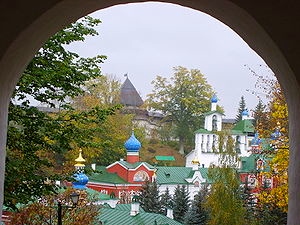
By the grace of God, the Pskov Caves Monastery escaped the religious persecution of the early Soviet Regime when it became part of the newly independent Estonia in 1920. The Soviet Union annexed Estonia in 1940; however, the following year the Germans invaded Estonia, thus inadvertently saving the monastery. After World War II, the Communist government allowed the monastery to remain open. Since the fall of Communism in Russia in 1992, restoration of the Pskov Caves Monastery has been accomplished, so that today it is a colorful and picturesque blend of medieval and Baroque architecture.
If you want to see 1986 footage of the monastic life of the Pskov-Caves Monastery in two parts (in Russian with English subtitles) go to:
http://www.youtube.com/watch?v=ySj8Mw1BkqU
http://www.youtube.com/watch?v=WrKCPY181CY
A modern day story of this monastery can be found on pages 257-261 of Everyday Saints and Other Stories, by Archimandrite Tikon (Shevkunov), “Father Avvakum and the Religious Affairs Commissioner from Pskov”.
Heroes of the Icon, by Fr. Steven Bigham, Oakwook Publications, Torrance, California, 1998
http://orthodoxlogos5.wordpress.com/2014/02/20/saints-and-feasts-beheading-of-the-venerable-cornelius-the-abbot-of-the-pskov-caves/r
http://orthodoxwiki.org/Cornelius_of_the_Pskov_Caves
http://www.rusartnet.com/russia/religion/monasticism/monastery/pskov-monastery-of-the-caves

BUILDING FUND UPDATE
Several of you have asked for numbers for our substantial building that’s meant to last till the second coming, God willing. Without the bricking, the estimates to finish the exterior total around $35,000. Currently, we have $72,166.81 in our building fund. The estimate for bricking is $86,000. Obviously, there isn’t enough money in the building fund to cover this expense. Our calculations indicate that $2 a brick will cover everything needed to brick the current building.
contribute as many bricks as you are able.
Saints Mary & Martha Orthodox Monastery
65 Spinner Lane
Wagener, South Carolina 29164
For pictures and updates on the “Building of Our Monastery”, you can now go to
http://www.saintsmaryandmarthaorthodoxmonastery.org/buildingplans.html



Saturday Liturgy Schedule
July 5th at 9 am
August 2nd at 9am
September 13th at 9am
October 4th at 9am
Matins starts at 8 am.
Clergy Wives Retreat
September 25-28, 2014
Contact Mother Beth Freeman: 865-660-6438
OR email her at beth.senes.@gmail.com

FROM MARTHA’S KITCHEN
RUTABAGA SOUP
Rutabagas are mild and somewhat sweet tasting.
1 large white onion, chopped
1 bunch of scallions, cut into ¼-inch lengths
8 large cloves garlic, peeled, crushed & chopped
3 stalks celery, thinly sliced
4 carrots, peeled & cut into rounds or half-rounds
1 large rutabaga, about 3½ pounds, peeled & cut into
½-inch cubes
1 Chinese cabbage, chopped
Prepare all of the vegetables above and place each in its own bowl.
2 cubes of vegetarian vegetable bouillon
¼ cup corn oil
1 Tablespoon yellow mustard seeds
1 Tablespoon caraway seeds
8-10 cups water
2 teaspoons salt
½ teaspoon freshly ground pepper
Dissolve bouillon cubes in ½ cup warm water and set aside.
In a large soup pot, add oil and mustard seeds, put the lid on and heat till mustard seeds pop. Just as the mustard seeds stop popping, add caraway seeds, white onion, scallions, and garlic till onions soften, about two minutes. Add celery, carrots, and rutabaga and sauté for four more minutes. Add cabbage and sauté for another minute. Add water till it is about 2 inches above vegetables. Add salt and pepper. Bring to boil. Reduce heat to low and simmer till the rutabaga and carrots are soft.
1 14-ounce package of extra firm tofu may be added to simmering soup for protein.